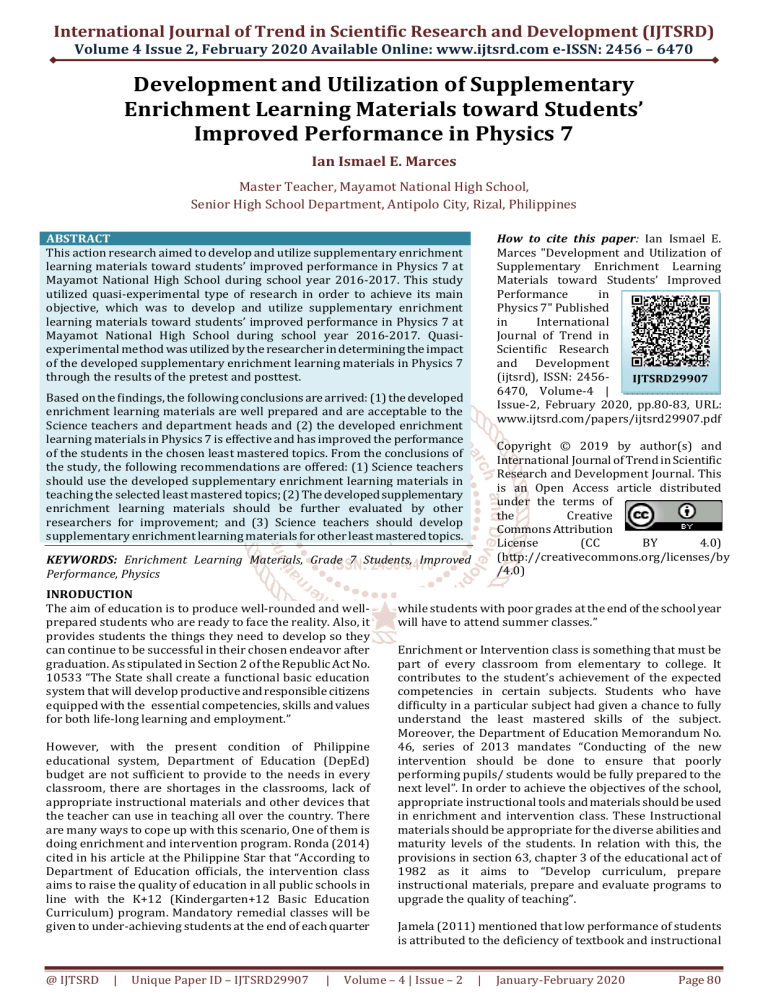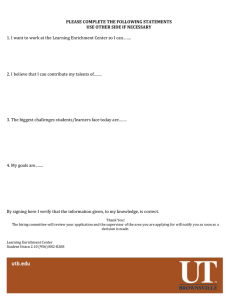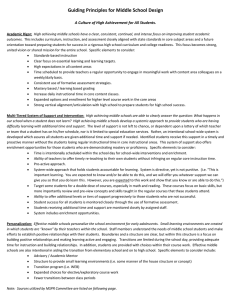
International Journal of Trend in Scientific Research and Development (IJTSRD)
Volume 4 Issue 2, February 2020 Available Online: www.ijtsrd.com e-ISSN: 2456 – 6470
Development and Utilization of Supplementary
Enrichment Learning Materials toward Students’
Improved Performance in Physics 7
Ian Ismael E. Marces
Master Teacher, Mayamot National High School,
Senior High School Department, Antipolo City, Rizal, Philippines
How to cite this paper: Ian Ismael E.
Marces "Development and Utilization of
Supplementary Enrichment Learning
Materials toward Students’ Improved
Performance
in
Physics 7" Published
in
International
Journal of Trend in
Scientific Research
and Development
(ijtsrd), ISSN: 2456IJTSRD29907
6470, Volume-4 |
Issue-2, February 2020, pp.80-83, URL:
www.ijtsrd.com/papers/ijtsrd29907.pdf
ABSTRACT
This action research aimed to develop and utilize supplementary enrichment
learning materials toward students’ improved performance in Physics 7 at
Mayamot National High School during school year 2016-2017. This study
utilized quasi-experimental type of research in order to achieve its main
objective, which was to develop and utilize supplementary enrichment
learning materials toward students’ improved performance in Physics 7 at
Mayamot National High School during school year 2016-2017. Quasiexperimental method was utilized by the researcher in determining the impact
of the developed supplementary enrichment learning materials in Physics 7
through the results of the pretest and posttest.
Based on the findings, the following conclusions are arrived: (1) the developed
enrichment learning materials are well prepared and are acceptable to the
Science teachers and department heads and (2) the developed enrichment
learning materials in Physics 7 is effective and has improved the performance
of the students in the chosen least mastered topics. From the conclusions of
the study, the following recommendations are offered: (1) Science teachers
should use the developed supplementary enrichment learning materials in
teaching the selected least mastered topics; (2) The developed supplementary
enrichment learning materials should be further evaluated by other
researchers for improvement; and (3) Science teachers should develop
supplementary enrichment learning materials for other least mastered topics.
Copyright © 2019 by author(s) and
International Journal of Trend in Scientific
Research and Development Journal. This
is an Open Access article distributed
under the terms of
the
Creative
Commons Attribution
License
(CC
BY
4.0)
(http://creativecommons.org/licenses/by
/4.0)
KEYWORDS: Enrichment Learning Materials, Grade 7 Students, Improved
Performance, Physics
INRODUCTION
The aim of education is to produce well-rounded and wellprepared students who are ready to face the reality. Also, it
provides students the things they need to develop so they
can continue to be successful in their chosen endeavor after
graduation. As stipulated in Section 2 of the Republic Act No.
10533 “The State shall create a functional basic education
system that will develop productive and responsible citizens
equipped with the essential competencies, skills and values
for both life-long learning and employment.”
However, with the present condition of Philippine
educational system, Department of Education (DepEd)
budget are not sufficient to provide to the needs in every
classroom, there are shortages in the classrooms, lack of
appropriate instructional materials and other devices that
the teacher can use in teaching all over the country. There
are many ways to cope up with this scenario, One of them is
doing enrichment and intervention program. Ronda (2014)
cited in his article at the Philippine Star that “According to
Department of Education officials, the intervention class
aims to raise the quality of education in all public schools in
line with the K+12 (Kindergarten+12 Basic Education
Curriculum) program. Mandatory remedial classes will be
given to under-achieving students at the end of each quarter
@ IJTSRD
|
Unique Paper ID – IJTSRD29907
|
while students with poor grades at the end of the school year
will have to attend summer classes.”
Enrichment or Intervention class is something that must be
part of every classroom from elementary to college. It
contributes to the student’s achievement of the expected
competencies in certain subjects. Students who have
difficulty in a particular subject had given a chance to fully
understand the least mastered skills of the subject.
Moreover, the Department of Education Memorandum No.
46, series of 2013 mandates “Conducting of the new
intervention should be done to ensure that poorly
performing pupils/ students would be fully prepared to the
next level”. In order to achieve the objectives of the school,
appropriate instructional tools and materials should be used
in enrichment and intervention class. These Instructional
materials should be appropriate for the diverse abilities and
maturity levels of the students. In relation with this, the
provisions in section 63, chapter 3 of the educational act of
1982 as it aims to “Develop curriculum, prepare
instructional materials, prepare and evaluate programs to
upgrade the quality of teaching”.
Jamela (2011) mentioned that low performance of students
is attributed to the deficiency of textbook and instructional
Volume – 4 | Issue – 2
|
January-February 2020
Page 80
International Journal of Trend in Scientific Research and Development (IJTSRD) @ www.ijtsrd.com eISSN: 2456-6470
materials in teaching the subject. Thus, it is important for the
teacher to know how to develop teaching aid and materials.
The selection of instructional materials should be based on
the needs, interest and capabilities of the pupils. Likewise,
Presidential Decree No. 6-A, Section 5 states that: “Designing,
utilizing and improving instructional technology and
developing or producing textbook and other instructional
materials will lead to quality education”. Developing
instructional materials is an important element in the
teaching-learning process. It is an instrument to make the
process of learning fruitful and systematic. Salandanan
(2001) as cited by Baltazar (2011) mentioned that
instructional materials, particularly printed materials, offer
the best means by which a teacher can provide directions in
his students’ daily search for new understanding and
verification.
The researcher being a science teacher chose to develop the
enrichment learning materials because he believes that
developing instructional materials will be a great help in the
further development of teaching and learning process. Also,
the researcher believes that the study could address the
school’s needs to provide suitable instructional materials for
intervention to cope with the least mastered topics. And
lastly, he strongly believes that the enrichment learning
materials in Science 7 will be used as a reviewer in different
achievement tests like Division Performance Test (DPT),
National Achievement Test (NAT) and National Career
Assessment Examination (NCAE).
Review of Related Literature
Intervention whether it is an enrichment or remediation
class is important to cope up with the current condition of
the Science education in the Philippines. As mentioned by
Selvarajan and Vasanthagumar (2012:51), remedial teaching
can also be defined, as the name implies, as designed to cater
to the needs of children unable to keep pace with the
teaching-learning process in a normal classroom. Remedial
teaching will act as a safety valve for the students who are
behind the expected level of achievement. It involves
diagnosis of specific difficulties, provide suitable remedial
measures and provide support to prevent reoccurring of
them again in future.
Furthermore, Ebert et.al (2011:458), claim that an
intervention is some effort that supplements normal
procedure either by providing remediation and enrichment,
or by extending or reducing responsibility or authority.
Interventions typically are in response to some specific need,
and though they can be a permanent change. Also, Remedial
teaching is to ensure the desired quality of learning. It is very
essential for ensuring effective learning and in improving the
quality
of
education.
(https://www.scribd.com/
doc/39375713/Remedial-Teaching)
For-at-risk children who do not appear to be making
sufficient progress to overcome their difficulties with
classroom instruction alone, it can be more than a bit of a
challenge to find time in the day to provide additional
intervention services. (Scanlon et.al, 2010:46) But of course,
it is also important to choose the suitable instructional
materials / tools during the intervention class. Agoo
(2012:12) in her article in the modern teacher, in order for
learning to be effective, teachers should use instructional
materials. These will also help the average learners to easily
@ IJTSRD
|
Unique Paper ID – IJTSRD29907
|
cope up with the lesson. Likewise, Hammerman (2010:33)
mentioned, Instructional materials can be powerful tools for
providing high quality instruction in the science classroom.
Well-designed units and carefully crafted lessons may be
used to guide the instructional process for all teachers.
One of the studies that are related to the present study was
conducted by Parales (2012), He developed a work text in
Physics which showed very significant results in increasing
the academic performance in Physics of fourth year students.
The experimental group or those students taught with the
use of the developed work text in Physics got a higher mean
percentage score compared to the control group or those
students taught with the use of the textbook from Dep.Ed.
Selpa (2012), on the development and validation of
enhancement activities in mathematics for grade VI pupils,
aimed to determine the effectiveness of the developed
enhancement activities in Mathematics. Based on the result
of her study, the developed enhancement materials in terms
of objectives was highly implemented; content was very
highly sufficient; in usefulness, it was found out to be
strongly useful; in language and style, it was strongly
effective. In terms of the level of performance of the studentrespondents, the student respondents showed high increase
in their mean percentage score after teaching them with the
developed enhancement activities in mathematics
Samonte (2012) on the development and validation of
interactive instructional material in elementary algebra, the
developed interactive instructional material was based on
the least mastered skills in elementary algebra. The study
revealed that the developed interactive instructional
material in elementary algebra was an effective instrument
for teaching-learning process since the student-respondents
shows a significant increase in their mastery level of the
chosen least mastered topics after using the interactive
instructional material in elementary algebra. Gomez (2014)
on development and validation of work text in food service
management, developed supplementary instructional
materials in teaching food service management which were
found to be very acceptable in terms of objectives, content,
language and style, usability, learning activities and graphics.
Se (2015) on the development and validation of
supplementary learning materials in drafting technology XI,
the developed materials increased the level of performance
of the student-respondents as reflected on their post-test.
Statement of the Problem
This action research aimed to develop and utilize
supplementary enrichment learning materials toward
students’ improved performance in Physics 7 at Mayamot
National High School during school year 2016-2017.
Specifically, it sought answers to the following questions:
1. What is the performance of the two groups of studentrespondents in pretest and posttest?
2. Is there a significant difference in the performance of
the two groups of student- respondents in pretest and
posttest?
Hypothesis
This study pursued the hypothesis that there is no significant
difference in the performance of the two groups of studentrespondents in pretest and posttest.
Volume – 4 | Issue – 2
|
January-February 2020
Page 81
International Journal of Trend in Scientific Research and Development (IJTSRD) @ www.ijtsrd.com eISSN: 2456-6470
METHODOLOGY
This study utilized quasi-experimental type of research in
order to achieve its main objective, which was to develop
and utilize supplementary enrichment learning materials
toward students’ improved performance in Physics 7 at
Mayamot National High School during school year 20162017.
Quasi-experimental method was utilized by the researcher in
determining the impact of the developed supplementary
enrichment learning materials in Physics 7 through the
results of the pretest and posttest.
Research Design
Group 1
(Control Group)
Without
Supplementary Enrichment
Learning Material
Group 2
Experimental Group)
With
Supplementary Enrichment
Learning Material
RESULTS AND DISCUSSION
Table1 Comparative Analysis between the
Performance of the Two Groups of Respondents in
Pretest
Control Experimental
Group
Group
Mean
6.17
1.3750
Sig. value
0.1735
Interpretation
Not Significant
Decision to Ho
Accept Ho
α = 0.05 Level of Significance
The table 1 presents the comparative analysis between the
performance of the two groups of respondents in pretest. It
can be gleaned from the table that there is no significant
difference in the pretest result of the two groups of
respondents as reflected in the t-value of 1.3750 with a sig.
value of 0.1735 which is greater than α = 0.05. Therefore, the
null hypothesis is accepted. This implies that the two groups
of respondents were comparable. However, even the
statistical result appeared not significant. As reflected in the
mean of the two groups, control group (x = 6.17) performed
higher than experimental (x = 5.83) in terms of pretest.
Table 2 Comparative Analysis between the
Performance of the Two Groups of Respondents in
Pretest
Control Experimental
Group
Group
24.26
35.89
t-value
1.1567
Sig. value
0.033
Interpretation
Significant
Decision to Ho
Reject Ho
|
1.
The developed enrichment learning materials are well
prepared and are acceptable to the Science teachers and
department heads.
2.
The developed enrichment learning materials in Physics
7 is effective and has improved the performance of the
students in the chosen least mastered topics.
Recommendations
In line with the findings and the conclusions of the study, the
following recommendations are offered:
1.
Science teachers should use the developed
supplementary enrichment learning materials in
teaching the selected least mastered topics.
2.
The developed supplementary enrichment learning
materials should be further evaluated by other
researchers for improvement.
3.
Science teachers should develop supplementary
enrichment learning materials for other least mastered
topics.
Unique Paper ID – IJTSRD29907
References
[1] Adriano, R. A. (2010). Academic Performance of Pupils
in Lessons Using Videotapes and the Inquiry Method
on Selected Topics in Science and Health VI.
(Unpublished Master’s Thesis). Marikina Polytechnic
College, Marikina City.
[2] Baltazar, M. G. (2011). Development and Evaluation of
Enrichment Materials in Elementary Mathematics III.
(Unpublished Master’s Thesis). Marikina Polytechnic
College, Marikina City.
[3] Bowen, C. W. (2010). Development and Validation of a
Curriculum Theory-based Classroom Environment
Instrument. University of Washington Journal, 5, 2-9.
[4] Buenaventura, M. S. (2014). Development and
Evaluation of Multimedia Reciprocal Instructional
Materials. (Unpublished Master’s Thesis). Marikina
Polytechnic College, Marikina City.
[5] Castro, M. M., et.al. (2012). RemedialTeaching. The
Modern Teacher, 61(1), 5.
[6] Delos Reyes, E. E. (2011). Development and Evaluation
of Content Area Vocabulary Enhancers (CAVE).
(Unpublished Master’s Thesis). Marikina Polytechnic
College, Marikina City.
[7] Ellis, T. J. (2012). Multimedia Enhanced Educational
Products as a Tool to Promote Critical Thinking in
Adult Students. Teacher, 10, 87-89.
α = 0.05 Level of Significance
@ IJTSRD
Conclusions
Based on the findings, the following conclusions are arrived
at:
5.83
t-value
Mean
The table 2 presents the comparative analysis between the
performance of the two groups of respondents in pretest. It
can be gleaned from the table that there is a significant
difference in the posttest result of the two groups of
respondents as reflected in the t-value of 1.1567 with a sig.
value of 0.033 which is less than α = 0.05. Therefore, the null
hypothesis is rejected. This implies that the experimental
group (x = 35.89) performed higher than control (x = 24.26)
in terms of posttest.
|
Volume – 4 | Issue – 2
|
January-February 2020
Page 82
International Journal of Trend in Scientific Research and Development (IJTSRD) @ www.ijtsrd.com eISSN: 2456-6470
[8] Gomez, J. P. (2014). Development and Validation of
Worktext in Food Service Management. (Unpublished
Master’s Thesis). University of Rizal System, Morong
Rizal.
[9] Jamela, E. R. (2011). Development and Evaluation of
Learning Activities in Hekasi IV Using Cognitive Maps.
(Unpublished Master’s Thesis). Marikina Polytechnic
College, Marikina City.
[10] Orap, J. M. (2014). Development and Evaluation of
Reinforcement Modules in Teaching Science (Physics)
Concepts for Grade VII. (Unpublished Master’s Thesis).
Marikina Polytechnic College, Marikina City.
[11] Parales, R. V. (2012). Development and Validation of
Work text in Physics for High School Fourth Year
Students. (Unpublished Master’s Thesis). University of
Rizal System, Morong, Rizal.
@ IJTSRD
|
Unique Paper ID – IJTSRD29907
|
[12] Reyes, E. S. (2014). Remedial Teaching. Retrived from
https://www.scribd.com/doc/39375713/RemedialTeaching
[13] Scanlon, D. M., et.al. (2010). Early Intervention for
Reading Difficulties. Spring Street, New York: The
Guilford Press.
[14] Selpa, V. T. (2012). Development and Validation of
Enhancement Activities in Mathematics for Grade VI
Pupils. (Unpublished Master’s Thesis). University of
Rizal System, Morong Rizal.
[15] Tamar a, N. L. (2010). Proposed Instructional Materials
in Science VI. (Unpublished Master’s Thesis). National
Teachers College, Manila.
[16] Torre, R. B. (2011). Development and Evaluation of
Contextualized Learning Material in General Science I.
(Unpublished Master’s Thesis). Marikina Polytechnic
College, Marikina
Volume – 4 | Issue – 2
|
January-February 2020
Page 83




